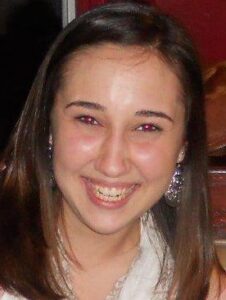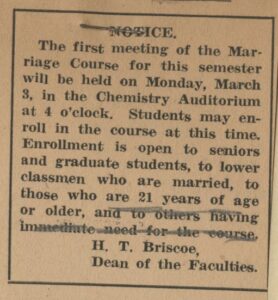
Lacey Guest, senior at Christopher Newport University in Virginia, recently visited IU Bloomington for research on IU’s well-known Alfred Kinsey and his Marriage Course. Lacey had a phenomenal time and agreed to share some of her discoveries as our first ever guest blogger!
__________________________________________
If you are like me, the first time you ever experienced a school sanctioned sex education course was in late elementary or early middle school. To us this seems completely normal… well somewhat normal. Regardless about how we felt at the time, being forced to watch a video about where babies come from as an adolescent is a fairly traditional rite of passage for my generation. Learning about the mechanics of reproduction was an integral part of public school education in the 1990s. Sure, my parents had to sign a permission slip and the class wasn’t mandatory, but while almost all the kids in my class had to sit through the awkward lesson plan, I distinctly remember that some kids were not allowed to go to the class and others were clearly hearing about the facts of life for the first time. Later, when high school biology and physical education classes both referenced this material, instead of red faces, our teachers got giggles and inappropriate comments from the peanut gallery. As familiar as this story probably is to most of us, it is a fairly new phenomenon that this institutionalized version of sex education was delivered to public school classrooms filled with adolescents. So how did we get here?
On my recent research trip to Bloomington I began to discover how some of the first American sex education classes began. I dug through collections at both the Kinsey Institute for Research in Sex, Gender, and Reproduction and the Indiana University Archives searching for anything I could find on the second “Kinsey report.” I stumbled across a few interesting tidbits of information about early 20th century sex education.

Undated IDS announcement regarding Marriage Course from Herman T. Briscoe’s files — presumably, with his edits.
I was shocked to discover that in the summer of 1938, IU joined a few other pioneering universities in providing what they called a “Marriage Course” to their upperclassmen and married students. This course was proposed by various organizations on campus to President Wells on May 14, 1938 and on June 9th, he brought it to the Board of Trustees who passed the motion for the organization of such a course under the chairmanship of Dr. Alfred C. Kinsey. Still shocked? I was. Not because of the chairman, and not because IU offered a Marriage Course. My surprise was founded on the information I gleaned from several of the student evaluations I came across.
The Marriage Course included lectures on several aspects of marriage given by a board of faculty members of various departments including psychology, biology, economics, and government. It came as no surprise to me that the student evaluations of the course praised the biology lectures with the most frequency or that when asked about the distribution of material for future semesters fifty-two of the ninety-eight students voted in favor of expanding the biology portion. I thought, “What college student isn’t a little preoccupied with what the Marriage Course had termed ‘The Anatomy and Physiology of Marriage?’” However, I was caught off guard when I noticed that ninety-seven of the ninety-eight students enrolled in the course listed the biology lectures as the “most significant in answering their personal needs.” With so much information at our fingertips today, our generation can just open a book or key an internet search for questions we have concerning the biology and physiology of sex. In 1938, Hoosiers had all their questions about sex, love, and marriage answered in a college classroom (if they met the qualifications to take the class). Since all of these students were seniors, graduates, married, or over the age of twenty one, it can be assumed that a vast majority of these young women and men sitting in on the Marriage Course lectures were already engaging in sexual behavior. The information provided in the course was interesting, but ultimately useless to many of the students according to their evaluations. One woman stated that it would have been very helpful information to have when she and her husband were undergoing their “sexual adjustment period.” The course seems to have filled a very noticeable gap in the American education system, but at a point in many students’ lives where the information was redundant. Kinsey wrote in his notes on the course that almost all the students in the course expressed “unreserved approval” regardless of their previous knowledge of the material.
 Fortunately, these glowing reviews of the course were taken into consideration when determining if it would become a more permanent fixture in IU’s course catalog. In the fall of 1938, with the full support of President Wells and the Board of Trustees, the Marriage Course was offered for the first time during the regular academic year as a sixteen week non-credit course. Its continued success can be fully discerned by looking through several of the letters and memos between the course staff, IU administration, and letters from students. The taboo of sex was slowly being eliminated through the process of education at the collegiate level and Indiana University faculty along with several other universities’ faculty across the country successfully pioneered this form of education in a quest to supply necessary information to their students. Today, there are over thirty undergraduate courses offered at Indiana University on the subjects of gender, sex, and sexuality. While these courses would no longer be considered as innovative or controversial as the 1938 Marriage Course once was, they still play a vital role in the discipline of sex education. While many people at the time found it disconcerting that IU would offer such a course to college students, today we can attribute the development of the Marriage Course to the insatiable Hoosier thirst for knowledge and commitment to education of all varieties.
Fortunately, these glowing reviews of the course were taken into consideration when determining if it would become a more permanent fixture in IU’s course catalog. In the fall of 1938, with the full support of President Wells and the Board of Trustees, the Marriage Course was offered for the first time during the regular academic year as a sixteen week non-credit course. Its continued success can be fully discerned by looking through several of the letters and memos between the course staff, IU administration, and letters from students. The taboo of sex was slowly being eliminated through the process of education at the collegiate level and Indiana University faculty along with several other universities’ faculty across the country successfully pioneered this form of education in a quest to supply necessary information to their students. Today, there are over thirty undergraduate courses offered at Indiana University on the subjects of gender, sex, and sexuality. While these courses would no longer be considered as innovative or controversial as the 1938 Marriage Course once was, they still play a vital role in the discipline of sex education. While many people at the time found it disconcerting that IU would offer such a course to college students, today we can attribute the development of the Marriage Course to the insatiable Hoosier thirst for knowledge and commitment to education of all varieties.
Leave a Reply